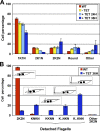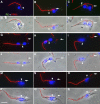Biogenesis of the trypanosome endo-exocytotic organelle is cytoskeleton mediated
- PMID: 18462016
- PMCID: PMC2365980
- DOI: 10.1371/journal.pbio.0060105
Biogenesis of the trypanosome endo-exocytotic organelle is cytoskeleton mediated
Abstract
Trypanosoma brucei is a protozoan parasite that is used as a model organism to study such biological phenomena as gene expression, protein trafficking, and cytoskeletal biogenesis. In T. brucei, endocytosis and exocytosis occur exclusively through a sequestered organelle called the flagellar pocket (FP), an invagination of the pellicular membrane. The pocket is the sole site for specific receptors thus maintaining them inaccessible to components of the innate immune system of the mammalian host. The FP is also responsible for the sorting of protective parasite glycoproteins targeted to, or recycling from, the pellicular membrane, and for the removal of host antibodies from the cell surface. Here, we describe the first characterisation of a flagellar pocket cytoskeletal protein, BILBO1. BILBO1 functions to form a cytoskeleton framework upon which the FP is made and which is also required and essential for FP biogenesis and cell survival. Remarkably, RNA interference (RNAi)-mediated ablation of BILBO1 in insect procyclic-form parasites prevents FP biogenesis and induces vesicle accumulation, Golgi swelling, the aberrant repositioning of the new flagellum, and cell death. Cultured bloodstream-form parasites are also nonviable when subjected to BILBO1 RNAi. These results provide the first molecular evidence for cytoskeletally mediated FP biogenesis.
Conflict of interest statement
Figures







Similar articles
-
Interaction between the flagellar pocket collar and the hook complex via a novel microtubule-binding protein in Trypanosoma brucei.PLoS Pathog. 2017 Nov 1;13(11):e1006710. doi: 10.1371/journal.ppat.1006710. eCollection 2017 Nov. PLoS Pathog. 2017. PMID: 29091964 Free PMC article.
-
Clathrin-dependent targeting of receptors to the flagellar pocket of procyclic-form Trypanosoma brucei.Eukaryot Cell. 2004 Aug;3(4):1004-14. doi: 10.1128/EC.3.4.1004-1014.2004. Eukaryot Cell. 2004. PMID: 15302833 Free PMC article.
-
Structural and functional studies of the first tripartite protein complex at the Trypanosoma brucei flagellar pocket collar.PLoS Pathog. 2021 Aug 2;17(8):e1009329. doi: 10.1371/journal.ppat.1009329. eCollection 2021 Aug. PLoS Pathog. 2021. PMID: 34339455 Free PMC article.
-
The trypanosome flagellar pocket.Nat Rev Microbiol. 2009 Nov;7(11):775-86. doi: 10.1038/nrmicro2221. Epub 2009 Oct 6. Nat Rev Microbiol. 2009. PMID: 19806154 Review.
-
Endocytosis, membrane recycling and sorting of GPI-anchored proteins: Trypanosoma brucei as a model system.Mol Microbiol. 2004 Aug;53(3):735-44. doi: 10.1111/j.1365-2958.2004.04224.x. Mol Microbiol. 2004. PMID: 15255888 Review.
Cited by
-
An analogue-sensitive approach identifies basal body rotation and flagellum attachment zone elongation as key functions of PLK in Trypanosoma brucei.Mol Biol Cell. 2013 May;24(9):1321-33. doi: 10.1091/mbc.E12-12-0846. Epub 2013 Feb 27. Mol Biol Cell. 2013. PMID: 23447704 Free PMC article.
-
Intrabody-Induced Cell Death by Targeting the T. brucei Cytoskeletal Protein TbBILBO1.Microbiol Spectr. 2021 Oct 31;9(2):e0091521. doi: 10.1128/Spectrum.00915-21. Epub 2021 Oct 27. Microbiol Spectr. 2021. PMID: 34704826 Free PMC article.
-
Structure of the TbBILBO1 protein N-terminal domain from Trypanosoma brucei reveals an essential requirement for a conserved surface patch.J Biol Chem. 2014 Feb 7;289(6):3724-35. doi: 10.1074/jbc.M113.529032. Epub 2013 Dec 20. J Biol Chem. 2014. PMID: 24362019 Free PMC article.
-
Crystal structure of the N-terminal domain of the trypanosome flagellar protein BILBO1 reveals a ubiquitin fold with a long structured loop for protein binding.J Biol Chem. 2020 Feb 7;295(6):1489-1499. doi: 10.1074/jbc.RA119.010768. Epub 2019 Dec 27. J Biol Chem. 2020. PMID: 31882537 Free PMC article.
-
Polo-like kinase phosphorylation of bilobe-resident TbCentrin2 facilitates flagellar inheritance in Trypanosoma brucei.Mol Biol Cell. 2013 Jun;24(12):1947-63. doi: 10.1091/mbc.E12-12-0911. Epub 2013 Apr 24. Mol Biol Cell. 2013. PMID: 23615446 Free PMC article.
References
-
- Landfear SM, Ignatushchenko M. The flagellum and flagellar pocket of trypanosomatids. Mol Biochem Parasitol. 2001;115:1–17. - PubMed
-
- Overath P, Engstler M. Endocytosis, membrane recycling and sorting of GPI-anchored proteins: Trypanosoma brucei as a model system. Mol Microbiol. 2004;53:735–744. - PubMed
-
- De Souza W. Secretory organelles of pathogenic protozoa. An Acad Bras Cienc. 2006;78:271–291. - PubMed
-
- Field MC, Natesan SK, Gabernet-Castello C, Lila Koumandou V. Intracellular trafficking in the trypanosomatids. Traffic. 2007;8:629–639. - PubMed
Publication types
MeSH terms
Substances
Associated data
- Actions
LinkOut - more resources
Full Text Sources
Other Literature Sources
Molecular Biology Databases

